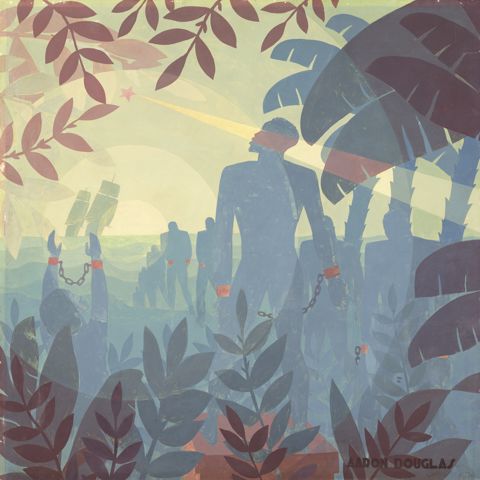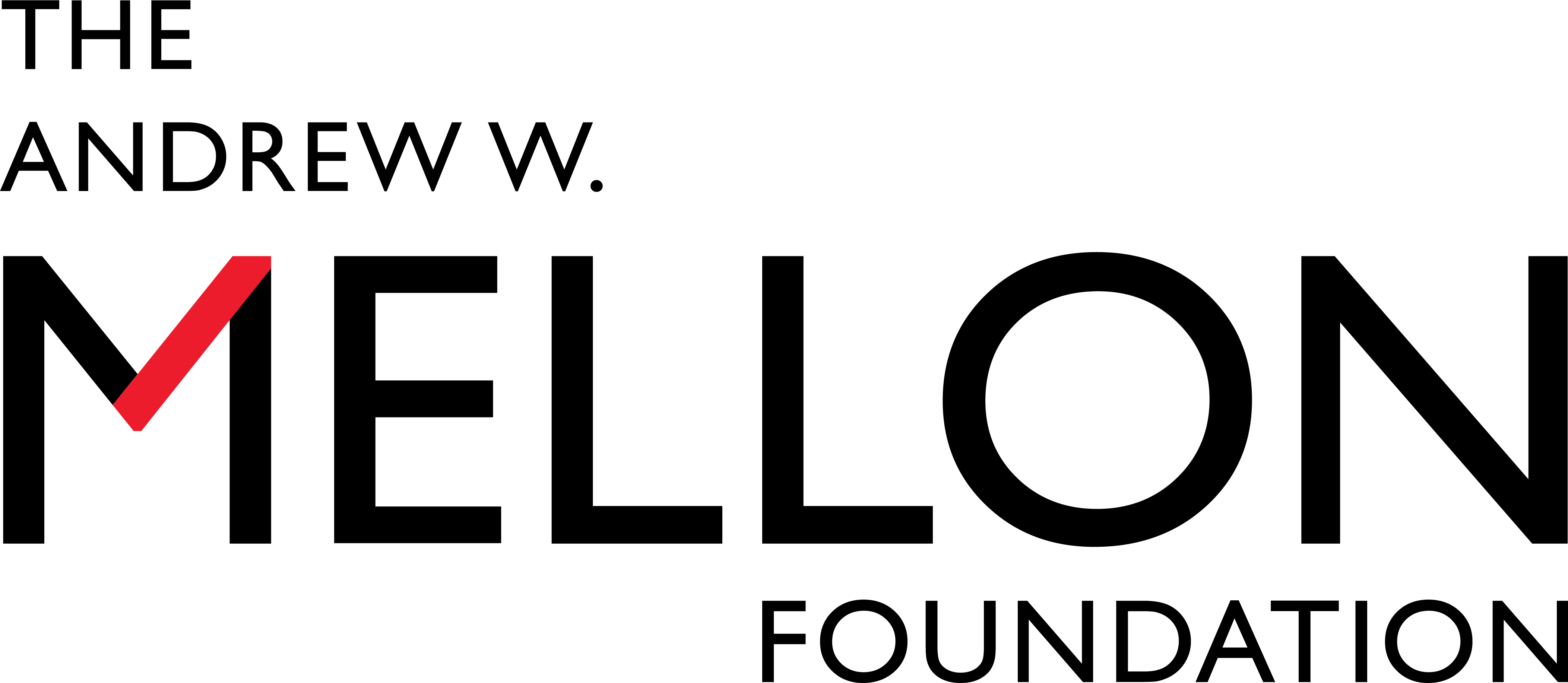Critically Acclaimed “Afro-Atlantic Histories” Will Open at MFAH October 24

Aaron Douglas, Into Bondage, 1936, oil on canvas, National Gallery of Art, Washington, DC, Corcoran Collection (museum purchase and partial gift from Thurlow Evans Tibbs, Jr., the Evans‐Tibbs Collection). © 2021 Heirs of Aaron Douglas / Licensed by VAGA at Artists Rights Society (ARS), NY
Exhibition re-examines narratives of westward diaspora through works spanning five centuries from Africa, the Americas, the Caribbean, and Europe
HOUSTON—OCTOBER 21, 2021—On October 24, the Museum of Fine Arts, Houston, will debut the U.S. tour of Afro-Atlantic Histories, an unprecedented exhibition that visually explores the history and legacy of the transatlantic slave trade. Initially organized and presented in 2018 by the Museu de Arte de São Paulo (MASP), the exhibition comprises more than 130 artworks and documents made in Africa, the Americas, the Caribbean, and Europe from the 17th to the 21st centuries.
In collaboration with MASP and the National Gallery of Art in Washington, DC, the MFAH will present Afro-Atlantic Histories at its Caroline Wiess Law Building from Sunday, October 24, 2021, through Monday, January 17, 2022. The exhibition will then travel to the National Gallery of Art to be on view in its West Building from Sunday, April 10, through Sunday, July 17, 2022, with the Los Angeles County Museum of Art and additional venues confirmed to follow.
“Afro-Atlantic Histories recasts the traditional telling of the colonial history of the Western hemisphere within the vast web of the transatlantic slave trade over three centuries,” commented Gary Tinterow, Director, Margaret Alkek Williams Chair, MFAH. “It is an essential reexamination, one that the MFAH and the National Gallery have distilled from its expansive, original presentation in Sao Paulo in 2018 to focus on forgotten perspectives under the theme of histórias.”
“The National Gallery is honored to partner with the Museu de Arte de São Paulo and the Museum of Fine Arts, Houston, to bring Afro-Atlantic Histories to the United States. In the nation’s capital, this exhibition will shed light on the many histories that are crucial to our understanding of the legacy of slavery across the Americas,” said Kaywin Feldman, Director of the National Gallery of Art. “Through works made by artists across five centuries, Afro-Atlantic Histories will also celebrate the ongoing influence of the African diaspora on both sides of the Atlantic.”
Exhibition Overview
Afro-Atlantic Histories dynamically juxtaposes works by artists from 24 countries, representing evolving perspectives across time and geography through major paintings, drawings and prints, sculptures, photographs, time-based media art, and ephemera. The range extends from historical paintings by Frans Post, Jean-Baptiste Debret, and Dirk Valkenburg to contemporary works by Ibrahim Mahama, Kara Walker, and Melvin Edwards.
The U.S. tour further builds on the exhibition’s overarching theme of histórias—a Portuguese term that can encompass both fictional and non-fictional narratives of cultural, economic, personal, or political character. The term is plural, diverse, and inclusive, presenting viewpoints that have been marginalized or forgotten. The exhibition unfolds through six thematic sections that explore the varied histories of the diaspora.
• Maps and Margins illustrates the beginnings of the slave trade as it unfolded across the Atlantic between Africa, the Americas, and Europe. Highlights include artworks that reference the widely reproduced British Abolitionist document “description of a slave ship” (1789), an illustration that clinically detailed a slave ship’s cargo hold; Aaron Douglas’s painting Into Bondage (1936), a powerful portrayal of the moment when a group of Africans are taken to a slave ship bound for the Americas.
• Enslavements and Emancipations examines how the abuses of commercial slavery triggered rebellion, escape, and Abolitionist movements. Theodor Kaufmann’s On to Liberty (1867) portrays women and children fleeing through the woods—a scene that Kaufmann, who served as a Union Solider during the American Civil War, witnessed firsthand. Torturous practices are addressed in works that range from “The Scourged Back,” the widely published 1863 photograph by McPherson & Oliver, to the 2009 etching Restraint, a powerful image of a silhouetted figure in an iron brindle, by American artist Kara Walker. Samuel Raven’s Celebrating the Emancipation of Slaves in British Dominions, August 1834 (c. 1834) presents a romanticized tribute to emancipation; Ernest Crichlow’s portrait of Harriet Tubman honors the fearless liberator and “conductor” of the Underground Railroad.
• Everyday Lives features images of daily life in Black communities during and after slavery, in realistic and romanticized views. Among 20th-century artists, American Clementine Hunter and Brazilian Heitor dos Prazeres depict field work and friendships. American Romare Bearden draws inspiration from the rhythmic and improvised staccato of jazz and the blues, using shifts in scale, breaks in color, and disarranged perspectives for his depiction of a sharecropper in the monumental collage Tomorrow I May Be Far Away (1967). The pastoral painting Landscape with Anteater (c. 1660), by the Dutch artist Frans Post, places enslaved laborers and indigenous peoples in an idyllic Brazilian landscape.
• Rites and Rhythms features works about celebrations and ceremonies in the Americas and the Caribbean. Often re-creating African traditions, these rites became channels for worship and communication. Twentieth-century Uruguayan artist Pedro Figari frequently portrayed his country’s Candombe dances, which originated with descendants of enslaved Africans. Dominican artist Jaime Colson’s lively Merengue (1938) pays homage to his country’s national dance and music, a blend of Afro-Caribbean rhythms and African movements. Other works in this section of the exhibition explore Carnival, African-based religions, and the historical Black presence in Christianity.
• Portraits spotlights Black leaders of the 18th and 19th centuries who have not traditionally been memorialized in historical American and European portraiture. Dalton Paula’s Zeferina (2018), commissioned for the original presentation at MASP, provides a face to an influential slave rebellion leader who was arrested and sentenced to death before she could be commemorated. Other historical and more contemporary works feature ordinary people, invented figures, and the artists themselves, including Self-Portrait (as Liberated American Woman of the ’70s) (1997) by Cameroonian photographer Samuel Fosso, an unconventional work that challenges our understanding of self-portraiture.
• Resistances and Activism examines the continuing fight for freedoms. Banners, flags, and textiles referring to histories of resistance across the Afro-Atlantic invoke cultural, political, religious, and artistic identities. Me gritaron negra (They shouted black at me) (1978), a video by Venezuelan artist Victoria Santa Cruz, is a powerful renunciation of colorism and racism through poetry and dance inspired by the artist’s own history. Other works in this section draw attention to Black activism, including Glenn Ligon’s painting Untitled (I Am a Man) (1988), inspired by signs carried in the 1968 Memphis Sanitation Workers’ Strike, which protested unsafe working conditions and low wages; and March on Washington (1964), a rare figurative painting by Alma Thomas that recalls her experience attending the storied demonstration.
Publication
MASP is producing an expanded edition of its 2018 exhibition catalogue for the U.S. tour. Afro-Atlantic Histories will include essays by Adriano Pedrosa, Ayrson Heráclito, Deborah Willis, Hélio Menezes, Kanitra Fletcher, Lilia Moritz Schwarcz, and Vivian Crockett. It is being published by MASP and Delmonico Books.
Related Events
• Virtual Discussion “Afro-Houston Histories,” October 25, 6:30 p.m. Presented by the MFAH and the African American Library at the Gregory School, this discussion adds a local perspective through a look at historic Houston sites that resonate with the themes of the exhibition. The enlightening conversation illuminates the glory and struggle of Houston’s African American history.
• Umbanda: Offerings of Faith, November 19, 7 p.m. & November 20, 2 p.m. Directed by Elisa Herrmann, this new documentary from Brazil examines the history of Umbanda, a religion founded in Rio de Janeiro in 1908. Providing an overview of the religion’s background and rituals through interviews with priests, priestesses, and followers, the film considers Umbanda’s connection to African, European, and Indigenous beliefs, with observations from scholars whose research focuses on mythology and religions of African origin.
Visit mfah.org/afroatlantic for more information and additional programs.
Organization & Funding
This exhibition is co-organized by the Museum of Fine Arts, Houston, and the Museu de Arte de Sāo Paulo in collaboration with the National Gallery of Art, Washington, DC.
Major support provided by:
![]()

The U.S. tour is curated by Kanitra Fletcher, Associate Curator of African American and Afro-Diasporic Art at the National Gallery of Art. Adriano Pedrosa, Artistic Director; Ayrson Heráclito, Curator; Hélio Menezes, Curator; Lilia Moritz Schwarcz, Adjunct-Curator of Histories; and Tomás Toledo curated the exhibition at the Museu de Arte de São Paulo. At the National Gallery, the curatorial team also includes Molly Donovan, Curator of Contemporary Art, and Steven Nelson, Dean of the Center for the Advanced Study in the Visual Arts.
In Washington, DC, the curators are working closely with an external advisory group of local leading historians and art historians: Ana Lucia Araujo, Professor of History, Howard University; Nicole Ivy, Assistant Professor of American Studies, George Washington University; Kevin Tervala, Associate Curator of African Art, Baltimore Museum of Art; Kristine Juncker, Special Assistant to the Director, National Museum of African Art; and Michelle Joan Wilkinson, Curator, Smithsonian National Museum of African American History and Culture.
About the Museum of Fine Arts, Houston
Established in 1900, the Museum of Fine Arts, Houston, is among the 10 largest art museums in the United States, with an encyclopedic collection of nearly 70,000 works dating from antiquity to the present. The Museum’s Susan and Fayez S. Sarofim main campus comprises the Audrey Jones Beck Building, designed by Rafael Moneo and opened in 2000; the Caroline Wiess Law Building, originally designed by William Ward Watkin, with extensions by Ludwig Mies van der Rohe completed in 1958 and 1974; the Lillie and Hugh Roy Cullen Sculpture Garden, designed by Isamu Noguchi and opened in 1986; the Glassell School of Art, designed by Steven Holl Architects and opened in 2018; The Brown Foundation, Inc. Plaza, designed by Deborah Nevins & Associates and opened in 2018; and the Nancy and Rich Kinder Building, also by Steven Holl Architects, opened in 2020. Additional spaces include a repertory cinema, two libraries, public archives, and facilities for conservation and storage. Nearby, two house museums—Bayou Bend Collection and Gardens, and Rienzi—present American and European decorative arts. The MFAH is also home to the International Center for the Arts of the Americas (ICAA), a leading research institute for 20th-century Latin American and Latino art. mfah.org
About the National Gallery of Art
The National Gallery of Art, founded as a gift to the nation, serves as a center of visual art, education, and culture. The National Gallery’s collection of more than 150,000 paintings, sculpture, decorative arts, photographs, prints, and drawings spans the history of Western art and showcases some of the triumphs of human creativity. Across 363 days a year, the National Gallery offers a full spectrum of special exhibitions and public programs free of charge. nga.gov
Media Contact
Melanie Fahey, Senior Publicist
mfahey@mfah.org | 713.800.5345
